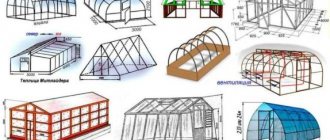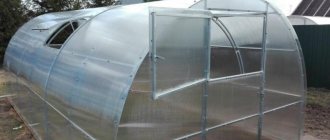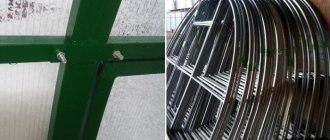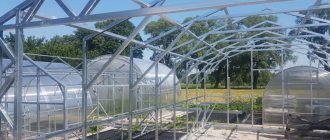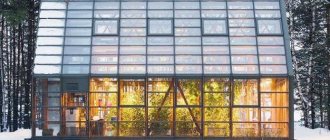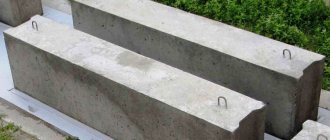Building a greenhouse with your own hands is a completely feasible task that even people with minimal construction skills can cope with. However, in order for the structure to be technologically correct and symmetrical, it is necessary to carry out some calculations even before the start of its construction.
Calculating the amount of material needed and calculating the size of a future building is a rather complex process that requires extreme care. The reliability of the building and its ease of use will depend on this. In this article we will look at the basic calculations that must be carried out before building arched and domed greenhouses from various materials.
- Dome
Greenhouse calculation
Some summer residents have a question about why it is necessary to calculate a greenhouse at all, because it is enough to simply build a base of the required shape and size, install supports and cover the structure with film or polycarbonate.
In fact, correctly carried out calculations are the key to successful construction. Not only the reliability of the finished structure, but also the financial side of the issue will depend on this. With a correct calculation, you will be able to find out exactly what material you will need for construction and how much of it you should buy.
There are many services on the Internet that provide online calculation of all necessary materials. Such online calculators are really very convenient and save a lot of effort and energy for those who are not confident in their own mathematical knowledge. However, to be completely sure that the calculation is correct, it is better to check the data obtained by performing the calculation manually. Next we will tell you how to do it correctly.
Find the arc length of the expanding arc for an angle of 7pi/5 radians on a circle of radius 3.
James J.
asked • 08/25/17
Determine the arc length for the outgoing arc described in the question.
More
с = rθ
c = 3 (7π / 5)
c = 21π / 5
Still looking for help? Get the right answer quickly.
OR
Find an online tutor now
Choose a specialist and meet online. No packages or subscriptions, pay only for the time you need.
¢ € £ ¥ ‰ μ · • § ¶ ß « » ≤ ≥ — — ¯ ~ ¤ | ¨ ¡ ¿ ~ ° — ± ÷ / × ƒ ∫ Σ ∞ √ ~ ≅ ≈ ≠ ≡ ∈ ∉ ∋ Π ∧ ∨ ¬ ∩ ∪ ∂ ∀ ∃ ∅ ∇ * α ∠ ' ¸ ª º † ‡ À Á Â Ã Ä Å Æ BZ E. Ê Ë I YA YA Ð TsTS Ò Ó F Õ Ö Ø O.N Š Ù Ú Û Ü Ý Ÿ Þ à á ã ä å æ ç è é ê ë I I I ð ñ ò ó ô õ ö ø œ š ù ú û ü ý þ ÿ Α Β Γ Δ Ε Ζ Η Θ Ι Κ Λ Μ Ν Ξ Ο Π Ρ Σ Τ Υ Φ Χ Ψ Ω α β γ δ ε ζ η θ ι κ λ μ ν ξ ο π ρ ς σ τ υ φ χ ψ ω ℵ π ℜ Υ ℘ ℑ ← ↑ → ↓ ↔ ↵ ⇐ ⇑ ⇒ ⇓ ⇔ ∴ ⊂ ⊃ ⊄ ⊆ ⊇ ⊕ ⊗ ⊥ ⋅ ⌈ ⌉ ⌊ ⌋ ◊ ,
Calculation of material for greenhouses
First of all, calculations will be needed in order to accurately calculate the required amount of material for construction. This process includes counting materials for building the foundation, installing the supports, and installing the covering.
The calculation directly depends on what materials you plan to use for construction. For example, wooden beams are often used to construct supports, but a profile pipe is considered a more practical and financially advantageous material. It is inexpensive, but quite strong and durable. In addition, the material of the pipe itself is practically resistant to fungi and mold, so the building frame will require a minimum of maintenance.
The calculation should also include roofing material: film, glass or polycarbonate. We will consider the calculation of the last type of roofing material, since polycarbonate is considered the most reliable and modern option for greenhouse covering.
Greenhouse made of profile pipe
A profile pipe is a metal product with a square, rectangular or oval cross-section. Untreated metal pipes are considered the most inexpensive, but galvanized or painted pipes are more suitable for humid environments. However, if you plan to connect structural elements by welding, it is better to buy uncoated pipes, since under the influence of the heat of welding the protective layer will in any case be destroyed and the pipe will have to be repainted.
Note: As a rule, for the construction of closed ground structures, square or rectangular pipes with dimensions of 20 x 20 or 20 x 40 mm are used.
If you connect the supports with bolts or other fastening fittings, you can safely buy galvanized pipe. However, preference should be given to the highest quality products, the galvanization of which will not crack over time. If the protective layer is damaged, all the properties of such galvanized pipes are lost, and the frame will begin to rust in a humid greenhouse environment.
Figure 1. Drawings of the frame of a gable and arched greenhouse made from a profile pipe
Before you start calculating a greenhouse made from a profile pipe, you should decide on the type of structure. The traditional option is a “house” - a building with a gable roof, but arched and domed structures are considered more modern. Their advantage is that snow does not accumulate on the roof, which can damage the coating, and there is enough space inside for caring for plants (Figure 1).
Note: Regardless of the type of construction chosen, it is better to immediately make the height of the building slightly larger than the height of a person. A lower design will, of course, save you some money, but it will not be very comfortable to work in a half-bent position.
Here are examples of calculations for the most popular types of greenhouses - gable and arched:
- Arched: usually has a height of about 1900-2400 mm. Based on this, we can conclude that an arch is half a full circle. Accordingly, we need to calculate the circumference using the formula L=n*D. The number n (Pi) is a constant value that is equal to 3.14, and D (diameter) is equal to two radii. In our case, the height of the structure is the radius. Let's assume that the height of the building will be two meters. Accordingly, the circumference L will be equal to 3.14 * 4, or 12.56 m. This figure must be divided in half. The result will be 6.28 m, which will correspond to the length of the curved arch. In this case, there is only one problem: the standard length of the profile pipe is 6 meters, so you will have to somehow attach a small piece to it. To simplify your task, it is better to make the height about 1850-1900 mm. In this case, the length of one curved arch will be exactly 6 meters.
- Gable: more difficult to calculate. First of all, it is necessary to take into account the angle of inclination of the roof, which fluctuates depending on the snow and wind load. The standard indicator is 30-45 degrees, and the optimal height of a building with a gable roof is 170-200 cm. To find out the height of the roof, you need to use the Pythagorean theorem, according to which the square of the hypotenuse is equal to the sum of the squares of the legs. Let's assume that the width of our greenhouse will be 2 meters, and the roof angle will be 30 degrees. In this case, the hypotenuse will be considered the length of the slope, and the legs will be an indicator of the width of the building. Using the same Pythagorean theorem, we find out that the leg lying opposite the angle of 30 degrees must be equal to half the hypotenuse. Having drawn up a quadratic equation, it turns out that the length of the hypotenuse is 1.154 m, respectively, the length of the leg is 0.58 m. Taking into account that the height of the wall is two meters, we can conclude that the height of the same structure along the ridge is 2.58 meters.
Using these calculations, you can calculate the required number of supports and arches. In this case, it is necessary to make a reserve, since in addition each greenhouse has doors and vents, which are also made from profile pipes.
Polycarbonate greenhouse
Polycarbonate is a roofing material that lets in enough light for normal plant development, but at the same time has increased strength. That is why it is most often used instead of fragile glass or short-lived film.
Figure 2. Drawings of polycarbonate buildings
As in the case of a profile pipe for constructing a frame, it is necessary to calculate the number of polycarbonate sheets required to cover the frame (Figure 2). First of all, you should take into account the thickness of the sheets. This indicator depends on the season of use of the building. If you plan to carry out work in it during the warm season, that is, from spring to autumn, sheets 5-10 mm thick will be sufficient. If you are planning to build a year-round heated greenhouse, it is better to give preference to sheets with a thickness of at least 15 mm.
There are a number of factors that must be taken into account when making calculations:
- Sheet size: you need to draw up a drawing of the future building in advance and plan the cutting of the roofing material so that the amount of waste is minimal.
- Properties of polycarbonate: when exposed to heat, this material tends to expand. This feature must be taken into account when calculating the number of sheets and cutting them.
- Possibility of bending: despite the fact that polycarbonate bends easily, some models of the material are quite difficult to give the required shape. Therefore, when purchasing, be sure to ask whether the sheet can be bent. This requirement plays a key role when covering arched and dome models.
It should also be taken into account that to attach polycarbonate you will need special fittings: end profiles, perforated tapes and special screws.
Calculating the required amount of polycarbonate for coating is quite simple. The standard sheet width is 2.1 meters. In this case, the stiffening ribs are located along the sheet, and during installation its edge must be fixed on supports made of a metal profile. In addition, you need to remember that the standard distance between the support posts is 0.7 or 1.05 meters, and the sheets are attached end-to-end using special connecting strips and self-tapping screws with thermal washers. Knowing the width of the sheet and the number of racks in your building, you can easily calculate the required amount of roofing material.
Arc calculation
You will need this type of calculation if you plan to build an arched greenhouse (Figure 3).
Note: The key role in the calculations is played by the total height of the building and the standard size of the polycarbonate sheets.
A standard polycarbonate sheet is 2.1 meters wide and 6 meters long. Accordingly, it is the length that will be the decisive factor in determining the height of the building.
Figure 3. Example of arc calculation
In order to give the sheet an arched shape, it is laid across the frame. In this case, the width of the entire structure will be about 3.80 meters, and the radius of the semicircle will be 1.90 meters. If we focus on the geometric formulas and calculations given in the previous sections, we can conclude that the height of the building will be equal to the radius, that is, it will be 1.90 meters. Unfortunately, this height of the greenhouse is not suitable for everyone, therefore, to increase the height, it is recommended to equip a basement for construction.
What is polycarbonate
There are two types of polycarbonate - cellular and monolithic. For roofing work, as well as for the construction of auxiliary buildings on the site, including gazebos and greenhouses, the cellular version is mainly used. This is a transparent, flexible sheet material consisting of three layers:
- Upper layer . It is a sheet of polycarbonate, which is covered on top with a protective film that does not allow sunlight to destroy the material.
- The middle layer is a cellular layer. Hollow cells with polycarbonate walls give the material high thermal insulation characteristics and also make it lightweight. The walls of the cells act as a kind of stiffening ribs, due to which the material is characterized by quite high strength.
- The bottom layer is another solid sheet of polycarbonate, but without a protective coating.
Calculation of the size of different types of greenhouses
There are several types of greenhouses that are in particularly high demand. The first is considered an arched structure, which is easy to build with your own hands. In addition, it is easy to work in such a structure, and thanks to the design features of the building, light and heat are optimally distributed inside and plants develop more evenly.
The second popular type of greenhouse is the domed one. This is a relatively new type of building, but due to its unusual appearance it is widely popular among those who not only want to grow vegetables, berries and herbs with their own hands, but also make such a building an original decoration for the site.
Dome
A dome greenhouse is also called a geodome. This is a building that looks like a large hemisphere. To build it, you will need many triangular and hexagonal frame elements that are connected to each other (Figure 4).
Note: Almost any material can be used to cover a dome building. An inexpensive design option is made of wood and film, while a more modern, durable and reliable option is considered to be one made of a profile pipe and polycarbonate.
Since a domed greenhouse is significantly different from other closed ground structures, its calculation should also be carried out taking into account similar features.
First of all, you will need certain materials for construction. The frame can be made from a profile pipe or wooden beams, and any available material (glass, film or polycarbonate) can be used as a covering. You will also need special petal connectors that connect the triangular frame elements to each other, and fittings (screws, nuts, bolts, awnings and handles), which will be needed for attaching the roofing material and making doors and vents.
Figure 4. Drawings and calculations required for the construction of a dome greenhouse
The main calculation that will be needed when building a dome model is to determine the area of the spherical dome. Fortunately, there are special online geodetic calculators on the Internet that will help not only calculate the volume of the dome, but also the number of necessary frame elements for its construction. You just need to enter the desired diameter and height of the building, and the system will automatically calculate all the necessary data. For example, if the greenhouse diameter is 4 meters and the height is 2 meters, you will need 35 and 30 triangles with edge lengths of 1.23 and 1.09 meters, respectively.
Frame
In order for the structure to last as long as possible, you need to choose the right material for the frame that will hold the walls of the greenhouse. The most economical option is a wooden frame. If the wood is treated with a special protective antiseptic before installation, its service life will be at least 10 years.
A frame made of a metal profile will be more reliable, but also more expensive. This is the option used by manufacturing companies. A metal frame will last longer than a wooden one, and it is much more convenient to assemble.
Calculation of greenhouse lighting
In addition to the direct construction of the greenhouse, certain calculations are also required for its internal arrangement. Since light and heat play a key role in growing plants in open ground, we will look at how to correctly calculate the lighting and heating of closed ground structures.
The importance of calculating lighting is explained by the fact that plants require a certain amount of light for full development. If the light is too dim, the crops simply will not grow, and if the light is too bright, they may burn.
When calculating lighting, they are guided by the area of the room and the power of the lamps that are used for lighting. For example, a lamp with a power of 150 W can illuminate an area of 60*60 cm, which is great for small home greenhouses. In industrial structures, as a rule, lamps with a power of 1000 W are used, since they are capable of illuminating an area of 250 * 250 cm. The calculations necessary for installing greenhouse lighting are given in Table 1.
Table 1. Calculation of the power of lighting devices for illuminating closed ground structures
Knowing the area of the greenhouse, you can calculate the required number of lamps of a certain power. At the same time, in small buildings it is not recommended to use too powerful lighting devices, as they can burn the plants. In addition, it should be taken into account that the lamps must be at a certain distance from the plants, and the higher the lamp power, the greater the distance should be. Therefore, in home greenhouses it is not recommended to use powerful lamps, from which the plants can simply burn out, and the optimal distance from the lamp to the beds must be determined gradually: first, hang the lighting fixtures at the maximum height, and if signs of light deficiencies are detected, the distance can be reduced.
How to properly heat
Greenhouse door
Now it is important to take care of the insulation and heating system of the greenhouse. Modern technologies involve the use of transparent or bubble plastic to insulate the greenhouse from the inside and outside
The benefit of this solution is that this material does not absorb sunlight and looks decent.
Heating methods:
- Stove heating - for this purpose, a stove or barbecue is built, and ventilation is installed to ventilate the room. The disadvantage of this method is that the heat is distributed unevenly over the area of the greenhouse.
- Electric heating is carried out using a convector and heating elements. In this case, ventilation is not needed.
- Water heating is carried out by installing pipes to which hot water is supplied using a pump from a boiler, which is heated by electricity, gas or coal. Ventilation is required when using gas and solid fuels. This method is also labor-intensive and expensive.
- Gas heating is produced using catalyst burners. This requires constant ventilation and ventilation throughout the greenhouse.
Heating in a greenhouse may not be entirely economical, but, as they say, the goal, and in our case, to reap a rich harvest, justifies the means.



